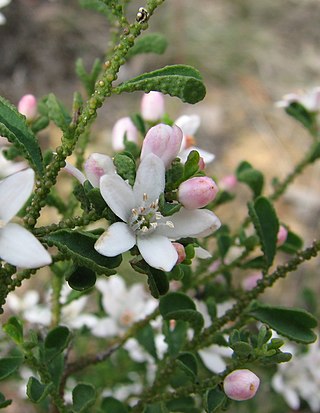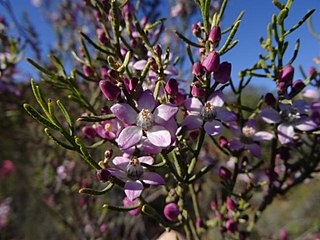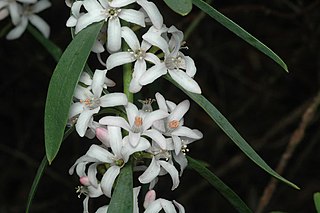
Philotheca is a genus of about fifty species of flowering plants in the family Rutaceae. Plants in this genus are shrubs with simple leaves arranged alternately along the stems, flowers that usually have five sepals, five petals and ten stamens that curve inwards over the ovary. All species are endemic to Australia and there are species in every state, but not the Northern Territory.

Philotheca verrucosa, commonly known as fairy wax-flower or Bendigo wax-flower, is a species of flowering plant in the family Rutaceae and is endemic to south-eastern Australia. It is a small shrub with prominently glandular-warty branchlets, heart-shaped or egg-shaped leaves with the narrower end towards the base, and white flowers usually arranged singly in leaf axils.

Philotheca myoporoides, commonly known as long-leaf wax flower, is a species of flowering plant in the family Rutaceae and is endemic to south-eastern Australia. It is a shrub with sessile, oblong to egg-shaped, glandular-warty leaves and white to pink flowers arranged singly in leaf axils. Prior to 1998 it was known as Eriostemon myoporoides.
Philotheca pungens, commonly known as prickly waxflower, is a species of flowering plant in the family Rutaceae and is endemic to south-eastern Australia. It is an undershrub with linear to narrow oblong or needle-like leaves and white flowers usually arranged singly in leaf axils.

Philotheca trachyphylla, commonly known as rock wax-flower, is a species of plant in the family Rutaceae and is endemic to south-eastern Australia. It is a shrub or small tree with glandular-warty, oblong to narrow egg-shaped leaves and white flowers arranged singly or in twos or threes, in leaf axils.

Philotheca angustifolia, commonly known as narrow-leaf wax flower, is a species of flowering plant in the family Rutaceae and is endemic to south-eastern Australia. It is a shrub with small leaves and white flowers with five egg-shaped petals in spring.

Philotheca brucei is a species of flowering plant in the family Rutaceae and is endemic to Western Australia. It is a shrub with cylindrical leaves grooved along the top and in spring, white to pink or mauve flowers with five egg-shaped petals.
Philotheca apiculata is a species of flowering plant in the family Rutaceae and is endemic to the south-west of Western Australia. It is a small shrub with narrow club-shaped leaves and small clusters of white to pink flowers on the ends of branchlets.

Philotheca conduplicata is a species of flowering plant in the family Rutaceae and is endemic to eastern Australia. It is a shrub with elliptical leaves clustered near the ends of the branchlets and white flowers arranged singly or in two or threes on the ends of the branchlets.

Philotheca epilosa is a species of flowering plant in the family Rutaceae and is endemic to eastern Australia. It is a shrub with egg-shaped to lance-shaped leaves with the narrower end toward the base and crowded near the ends of the glandular-warty branchlets, and white flowers usually arranged singly on the ends of the branchlets.
Philotheca glabra is a species of flowering plant in the family Rutaceae and is endemic to the inland south-west of Western Australia. It is a small shrub with elliptical to club-shaped leaves and white flowers tinged with pink and arranged singly or in twos or three on the ends of branchlets.

Philotheca myoporoides subsp. acuta is a subspecies of flowering plant in the family Rutaceae and is endemic to New South Wales. It is a shrub with narrow oblong or narrow elliptic leaves and white flowers arranged singly or in groups of up to three in leaf axils.

Philotheca myoporoides subsp. brevipedunculata is a subspecies of flowering plant in the family Rutaceae and is endemic to New South Wales. It is a shrub with oblong or egg-shaped leaves and white or pink flowers arranged singly or in groups of up to three in leaf axils.
Philotheca myoporoides subsp. euroensis is a subspecies of flowering plant in the family Rutaceae and is endemic to a small area in Victoria, Australia. It is a small shrub with curved, broadly elliptic leaves and white or pink flowers arranged singly or in groups of up to four in leaf axils.

Philotheca myoporoides subsp. myoporoides, commonly known as long-leaf wax flower, is a subspecies of flowering plant in the family Rutaceae and is endemic to south-eastern continental Australia. It is a shrub with oblong to elliptic or egg-shaped leaves and white or pink flowers arranged in groups of three to eight in leaf axils.
Philotheca nutans is a species of flowering plant in the family Rutaceae and is endemic to the south-west of Western Australia. It is a small, densely-branched shrub with club-shaped to cylindrical, glandular-warty leaves and pendent, pale yellow to pale red flowers arranged singly in leaf axils.
Philotheca obovatifolia, commonly known as mountain wax-flower, is a species of flowering plant in the family Rutaceae and is endemic to eastern Australia. It is a small shrub with broadly egg-shaped leaves with the narrower end toward the base and densely crowded near the ends of the glandular-warty branchlets, and cream-coloured flowers tinged with pink and arranged singly or in groups of up to five in leaf axils.

Philotheca queenslandica is a species of flowering plant in the family Rutaceae and is endemic to south-eastern Queensland. It is a wiry shrub with elliptic to egg-shaped leaves with the narrower end toward the base and densely crowded near the ends of the glandular-warty branchlets, and cream-coloured flowers tinged with pink and arranged singly in leaf axils.

Philotheca virgata, commonly known as Tasmanian wax-flower, is a species of flowering plant in the family Rutaceae and is endemic to south-eastern Australia. It is a slender, erect shrub with wedge-shaped to oblong leaves and white or pale pink flowers at the ends of branchlets. It is the only philotheca with four sepals and petals.
Philotheca wonganensis, commonly known as Wongan philotheca, is a species of flowering plant in the family Rutaceae and is endemic to the south-west of Western Australia. It is a shrub with thin, cylindrical leaves and white flowers with a pink central stripe, usually arranged singly in leaf axils.












